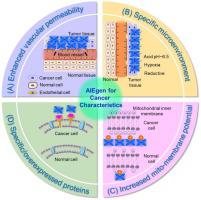Materials Science and Engineering: R: Reports ( IF 31.6 ) Pub Date : 2021-11-02 , DOI: 10.1016/j.mser.2021.100649 Ruoyao Zhang 1, 2 , Xiaolin Huang 3 , Chao Chen 1, 4 , Ryan T.K. Kwok 1, 4 , Jacky W.Y. Lam 1, 4 , Ben Zhong Tang 1, 4, 5

|
Cancer is one of the most severe diseases and is challenging human health and longevity. Cancer diagnosis is extremely important to improve the survival rate of patients. Cancer tissues/cells have been characterized with four distinctive biological features that significantly differ from normal tissues/cells, including higher vascular permeability, specific microenvironments of acidic pH, high reducibility and hypoxia, higher mitochondrial membrane potential, and overexpressed proteins. Therefore, accurate cancer discrimination can be achieved by targeting these characteristics. Currently, various imaging modalities have been developed to discriminate cancerous tissues/cells. Amongst, fluorescent technology has dominated the central position because it can directly, in-situ and real-time visualize and distinguish cancer tissues/cells at nano-micrometer resolution. Since its first discovery in 2001, aggregation-induced emission (AIE) has developed as a promissing and powerful fluorescent technique. Fluorogens with AIE characteristics (AIEgens) are non-emissive in molecular state, but show enhanced emission in aggregated state due to its restriction of intramolecular motion. Besides, AIEgens can work at high concentrations without considering the aggregation-caused quenching effect encountered by conventional organic fluorescent dyes. Given their unique superiorities, AIE-based fluorescent imaging technologies have emerged as appealing alternatives to traditional ones and obtained wide-ranging uses in cancer discrimination. Thus, herein we provide a comprehensive review of the recent progress of AIEgen-based fluorescent probes for cancer discrimination. These fluorescent probes can be classified into four categories, corresponding to four characteristics of cancer. The design strategies and working mechanisms for these probes and their applications for cancer bioimaging were highlighted and the pros and cons of these probes were criticized. Ultimately, this review will end with the discussion of future development of AIEgen-based cancer discrimination.
中文翻译:

AIEgen 用于癌症歧视
癌症是最严重的疾病之一,正在挑战人类的健康和长寿。癌症诊断对于提高患者的生存率极为重要。癌症组织/细胞具有四个与正常组织/细胞显着不同的独特生物学特征,包括更高的血管通透性、酸性 pH 值的特定微环境、高还原性和缺氧、更高的线粒体膜电位和过度表达的蛋白质。因此,可以通过针对这些特征来实现准确的癌症识别。目前,已经开发了各种成像方式来区分癌组织/细胞。其中,荧光技术占据了中心地位,因为它可以直接、以纳米微米分辨率原位实时可视化和区分癌症组织/细胞。自 2001 年首次发现以来,聚集诱导发射 (AIE) 已发展成为一种有前途且功能强大的荧光技术。具有 AIE 特性的荧光剂 (AIEgens) 在分子状态下不发射,但由于其分子内运动的限制,在聚集状态下显示出增强的发射。此外,AIEgens 可以在高浓度下工作,而无需考虑传统有机荧光染料遇到的聚集引起的猝灭效应。鉴于其独特的优势,基于 AIE 的荧光成像技术已成为传统技术的有吸引力的替代品,并在癌症识别方面获得了广泛的应用。因此,在此,我们全面回顾了基于 AIEgen 的荧光探针用于癌症鉴别的最新进展。这些荧光探针可以分为四类,对应癌症的四个特征。重点介绍了这些探针的设计策略和工作机制及其在癌症生物成像中的应用,并批评了这些探针的优缺点。最终,本次审查将以对基于 AIEgen 的癌症歧视未来发展的讨论结束。重点介绍了这些探针的设计策略和工作机制及其在癌症生物成像中的应用,并批评了这些探针的优缺点。最终,本次审查将以对基于 AIEgen 的癌症歧视未来发展的讨论结束。重点介绍了这些探针的设计策略和工作机制及其在癌症生物成像中的应用,并批评了这些探针的优缺点。最终,本次审查将以对基于 AIEgen 的癌症歧视未来发展的讨论结束。











































 京公网安备 11010802027423号
京公网安备 11010802027423号